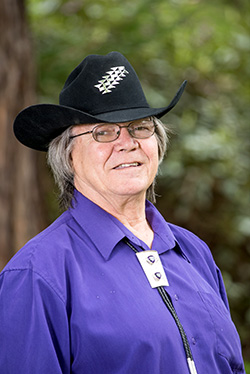
Blake will officially receive the honorary doctorate at a special campus event in Fall 2016.
Born in 1944 on the Hoopa Indian Reservation in the Hoopa Valley of Humboldt County, Blake is known for his sculpture, jewelry, regalia, and contemporary works. He is also recognized as one of the few living people skilled in the traditional art of dugout canoe building.
“We are deeply honored to be able to recognize George Blake. Through his traditional and contemporary work, George reminds us of the power of art to build connections across time and place,” says Humboldt State President Lisa Rossbacher.
Blake’s work has been exhibited widely nationally and internationally and is in the collections of major institutions, like the Phoebe A. Hearst Museum at UC Berkeley. In 1991, Blake was awarded the National Heritage Fellowship, the highest national honor given to a traditional artist. The National Endowment of the Arts website quotes Blake describing his work as a way to connect with his elders and the traditional arts: “I wanted to do what the old people did…. I make elk antler purses, and make them as different as I want … I mean, I could put elks on them, and all these other things and try to show skills an artist would. But I don’t. I just like the way they were done a long time ago. And I just keep making them.”
Blake served in the U.S. Army from 1963-66 before enrolling at College of the Redwoods. He later transferred to University of California, Davis, where he studied fine arts and Native American art.
From 1980 to 1983, Blake served as curator of the Hupa Tribal Museum, and while there he organized a broad program to teach the traditional arts to younger tribal members.
Blake is skilled in featherwork and the making of other regalia, as well as the carving of antlers into Hupa purses and spoons. By combining library research and oral instruction from tribal elders, Blake has learned bow-making and the craft of making dugout canoes. Several of Blake’s boats are exhibited in collections, including at the Humboldt State University Library.
Blake’s Yurok Dugout Canoe in the HSU Library was crafted between 1989 and 1990 by Blake and his nephew alongside six HSU apprentices. Traditionally, dugout canoes were made of old growth timber, but this neo-traditional canoe was sourced from a second-growth tree, representing a balance of Yurok tradition and contemporary environmental understanding. While this canoe has never been in the water, a second canoe made by the team was proven seaworthy on Humboldt Bay in 1990 with a crew of six. In all probability, that was the first dugout canoe to navigate the waters around Indian Island since the massacre of the Wiyot people in 1860.
HSU has presented a number of Honorary Doctorates over the years. Below is a list of past recipients:
- 2014, Hermann Spetzler (‘87), Honorary Doctor of Humane Letters
- 2012, Robert N. Klein, Honorary Doctor of Laws
- 2008, Cheryl A. Seidner, Honorary Doctor of Humane Letters
- 2008, Michael Randolph Fielding (’57, ’63), Honorary Doctor of Humane Letters
- 1998, Monica P. Hadley, Honorary Doctor of Humane Letters
- 1995, Gwynna M. Morris, Honorary Doctor of Humane Letters
- 1995, Fred. B. Galbreath, Honorary Doctor of Letters
- 1994, Louis W. Schatz, Honorary Doctor of Science
- 1965, Monroe E. Spaght, Honorary Doctor of laws
- 1985, Homer P. Balabanis, Honorary Doctor of Fine Arts